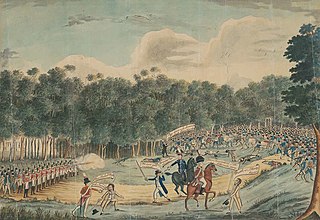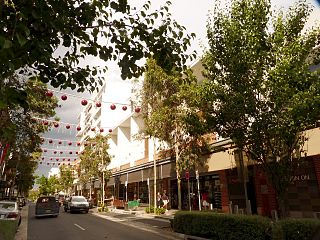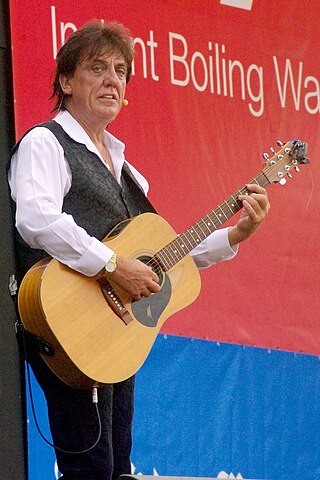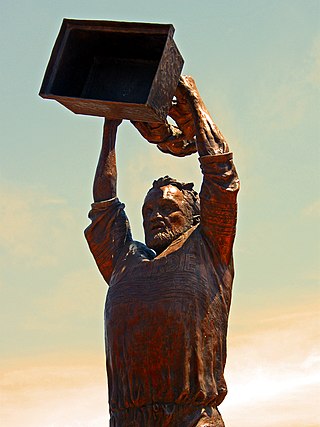Related Research Articles

Castle Hill is a suburb of Sydney, New South Wales, Australia, located 34 kilometres north-west of the Sydney central business district and 9.5 kilometres north of Parramatta. It is within the Hills District region, split between the local government areas of The Hills Shire and Hornsby Shire.
The New South Wales Corps, sometimes known as The Rum Corps was a regiment of the British Army, formed in England in 1789, to relieve the New South Wales Marine Corps, which had accompanied the First Fleet to Australia. In the Colony of New South Wales, the New South Wales Corps gained notoriety for its trade in rum and mutinous behaviour.

Greater Western Sydney (GWS) is a large region of the metropolitan area of Greater Sydney, New South Wales (NSW), Australia that generally embraces the north-west, south-west, central-west, far western and the Blue Mountains sub-regions within Sydney's metropolitan area and encompasses 13 local government areas: Blacktown, Blue Mountains, Camden, Campbelltown, Canterbury-Bankstown, Cumberland, Fairfield, Hawkesbury, Hills Shire, Liverpool, Parramatta, Penrith and Wollondilly. It includes Western Sydney, which has a number of different definitions, although the one consistently used is the region composed of ten local government authorities, most of which are members of the Western Sydney Regional Organisation of Councils (WSROC). Penrith, Hills Shire & Canterbury-Bankstown are not WSROC members. The NSW Government's Office of Western Sydney calls the region "Greater Western Sydney".
D'Arcy Wentworth was an Irish-Australian surgeon and the first paying passenger to arrive in the new colony of New South Wales. He served under the first seven governors of the Colony, and from 1810 to 1821, he was "great assistant" to Governor Lachlan Macquarie. Wentworth led a campaign for the rights and recognition of emancipists and for trial by jury.

The Hills District is a region of Sydney, within the northern part of the Greater Western Sydney region of Sydney, in the state of New South Wales, Australia. Stretching from the M2 Hills Motorway in the south to the Hawkesbury River in the north and Old Windsor Road in the west to Pennant Hills Road and Berowra Creek in the east, its constituent suburbs are located in the local government areas of The Hills Shire, and parts of Hornsby Shire.

Pemulwuy, also rendered as Pimbloy, Pemulvoy, Pemulwoy, Pemulwy or Pemulwye, or sometimes by contemporary Europeans as Bimblewove, Bumbleway or Bembulwoyan, was a Bidjigal man of the Eora nation, born around 1750 in the area of Botany Bay in New South Wales, Australia. One of the most famous Aboriginal resistance fighters in the colonial era, he is noted for his resistance to European colonisation which began with the arrival of the First Fleet in January 1788.
Ian Edward Swainson Jones was an Australian television writer and director and an author specialising in the history of notorious outlaw Ned Kelly and his gang.

The Castle Hill convict rebellion was an 1804 convict rebellion in the Castle Hill area of Sydney, against the colonial authorities of the British colony of New South Wales. Led by veterans of the United Irish Rebellion of 1798, the poorly armed insurgents confronted the colonial forces of Australia on 5 March 1804 at Rouse Hill. Their rout in the resulting skirmish was hailed by loyalists as Australia's Vinegar Hill after the 1798 Irish Battle of Vinegar Hill, where rebels in Ireland were decisively defeated. The incident was the first major convict uprising in Australian history to be suppressed under martial law.

Stanhope Gardens is a suburb of Greater Western Sydney, in the state of New South Wales, Australia. Stanhope Gardens is located 31 kilometres north-west of the Sydney central business district in the local government area of City of Blacktown.

Rouse Hill is a suburb of Sydney, in the state of New South Wales, Australia. Rouse Hill is located in the Hills District, 43 kilometres north-west of the Sydney central business district and 19 kilometres north-west of the Parramatta central business district. It is in the local government areas of The Hills Shire and City of Blacktown. Rouse Hill Town Centre is at the heart of the suburb, which contains a busy Town Square.

Jonathan James English was an English-born Australian singer, songwriter, musician and actor. He emigrated from England to Australia with his parents in 1961. He was an early vocalist and rhythm guitarist for Sebastian Hardie but left to take on the role of Judas Iscariot in the Australian version of the stage musical Jesus Christ Superstar from May 1972, which was broadcast on television. English was also a noted solo singer; his Australian top twenty hit singles include "Turn the Page", "Hollywood Seven", "Words are Not Enough", "Six Ribbons" and "Hot Town".

Raymond Alan Price is an Australian former dual-code international rugby union and rugby league footballer. He was nicknamed “Mr Perpetual Motion” for his hard, intimidating style of play in league at lock forward. Price played rugby league for Sydney's Parramatta Eels club, with whom he won four NSWRL premierships, a Dally M Medal and a Rothmans Medal. He also played in State of Origin for New South Wales.

Michael Dwyer was an insurgent captain in the Irish Rebellion of 1798, leading the United Irish forces in battles in Wexford and Wicklow., Following the defeat and dispersal of the rebel hosts, in July 1798 Dwyer withdrew into the Wicklow Mountains, and to his native Glen of Imaal, where he sustained a guerrilla campaign against British Crown forces.
James Squire, alternatively known as James Squires, was a First Fleet convict transported to Australia. Squire is credited with the first successful cultivation of hops in Australia around the start of the 19th century. First officially brewing beer in Australia in 1790; James later founded Australia's first commercial brewery making beer using barley and hops in 1798, although John Boston appears to have opened a brewery making a form of corn beer two years earlier.
Martin Mason was a surgeon, magistrate and commander who is notable as a pioneer settler of Australia, and also as a supporter of Captain Bligh following the 1808 Rebellion at Sydney, New South Wales.
The Battle of Parramatta was a battle of the Australian Frontier Wars which occurred at Parramatta in March 1797. In the conflict, Aboriginal resistance leader Pemulwuy led a group of Bidjigal warriors, estimated to be up to 100, against armed British settlers and soldiers of the New South Wales Corps. One Britisher was wounded and five Aboriginal people were killed with many others wounded. Pemulwuy himself was wounded and placed into custody.

Merriville House & Gardens is a heritage-listed residence at Eire Way, Kellyville Ridge, New South Wales, Australia. It was built from 1817 to 1855. It is also known as Hambledon Cottage, Hambledon and Maryville. It was added to the New South Wales State Heritage Register on 2 April 1999.

The Royal Oak Inn is a heritage-listed hotel located on the corner of Windsor Road and Commercial Road, in Rouse Hill in The Hills Shire local government area of New South Wales, Australia. It was built in 1829. It has also been known as the Queens Arms Inn, and is currently known as the Fiddler Hotel. The property is privately owned and was added to the New South Wales State Heritage Register on 2 April 1999.
Richard Rouse was an Anglo-Australian public servant who was active during the Colonial development of New South Wales as the Superintendent of Public Works and Convicts at Parramatta under the direction of NSW Governors William Bligh and Lachlan Macquarie. He is attributed as the designer of Rouse Hill House in Rouse Hill, that was his family home from 1819 until his death in 1852.
The Toongabbie Government Farm Archaeological Site is the heritage-listed site of a former convict government farm at Goliath Avenue, Winston Hills, City of Parramatta, New South Wales, Australia. The farm was built by convict labour from 1791 to 1813. Its site includes areas today known as Palestine Park, Oakes Reserve and Settlers Walk and is also known as the Toongabbie Government Farm Convict Site. It was added to the New South Wales State Heritage Register on 11 December 2012.
References
- ↑ Terrace, Vincent (1981). Television 1970–1980. San Diego: A.S. Barnes and Company. ISBN 0-498-02577-2.
- ↑ Personal recollection of the contributor whose family were neighbours during Bronwyn's early years.
- ↑ "The story of 'Against the Wind'". The Canberra Times . 29 October 1978. p. 7. Retrieved 11 August 2013– via National Library of Australia.
- 1 2 Albert Moran, Moran's Guide to Australian TV Series, AFTRS 1993 p 46
- ↑ "Australian TV shows top ratings". The Canberra Times . 30 December 1978. p. 3. Retrieved 11 August 2013– via National Library of Australia.
- ↑ Sadlier, Kevin. "Death of the Australian mini-series". Sydney Sun Herald. p. 47.
- ↑ Binns, Bronwyn; Jones, Ian (1978). Against The Wind. Australian Theatre Workshop Series (#19). Richmond, Victoria: Heinemann Educational Australia Pty Ltd. ISBN 0-85859-196-0.
- "The Dictionary of Performing Arts in Australia — Theatre . Film . Radio . Television — Volume 1" — Ann Atkinson, Linsay Knight, Margaret McPhee — Allen & Unwin Pty. Ltd., 1996
- "The Australian Film and Television Companion" — compiled by Tony Harrison — Simon & Schuster Australia, 1994